Before we even dive into this tiny collection, there are a few things that need to be cleared when talking about a notocactus.
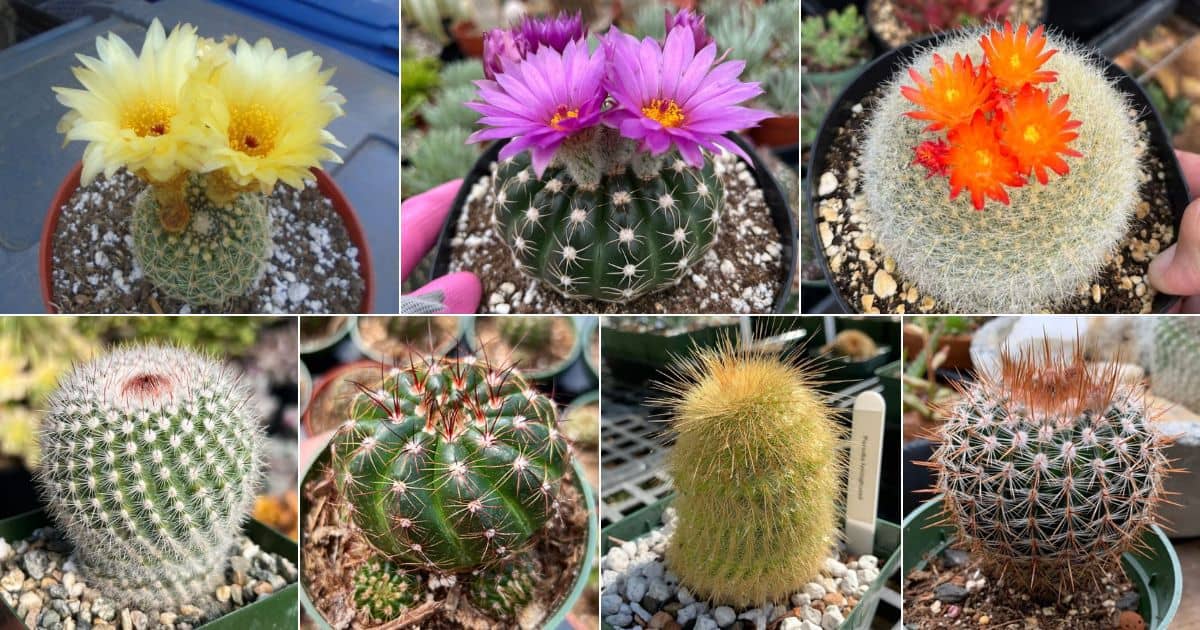
First, the notocactus used to be its own genus but was then absorbed into the Parodia genus. Second, the two are technically the same; however, a notocactus can show some characteristic differences in how it grows, and its spines are a little different: this makes it a specific group within the genus of Parodia.
As a final warning before we dive in here, the roots of this genus are very sensitive! It is very important to follow the watering directions and make sure that they are never left in standing water. A second warning for these tiny titans is that they generally don’t do well in full sun … ever. There are a few species that do, but they are few and far between.
Jump to:
- 1. Notocactus leninghausii
- 2. Notocactus Schlosseri
- 3. Notocactus Buiningii
- 4. Notocactus haselbergii
- 5. Notocactus Uebelmannianus
- 6. Notocactus Concinnus
- 7. Parodia Scopa
- 8. Notocactus Magnificus
- 9. Notocactus Elegans
- 10. Notocactus Ottonis
- 11. Notocactus Werdermannianus
- 12. Notocactus Roseoluteus
- 13. Notocactus mammulosus
- 14. Parodia mueller-melchersii
- 15. Notocactus apricus
1. Notocactus leninghausii
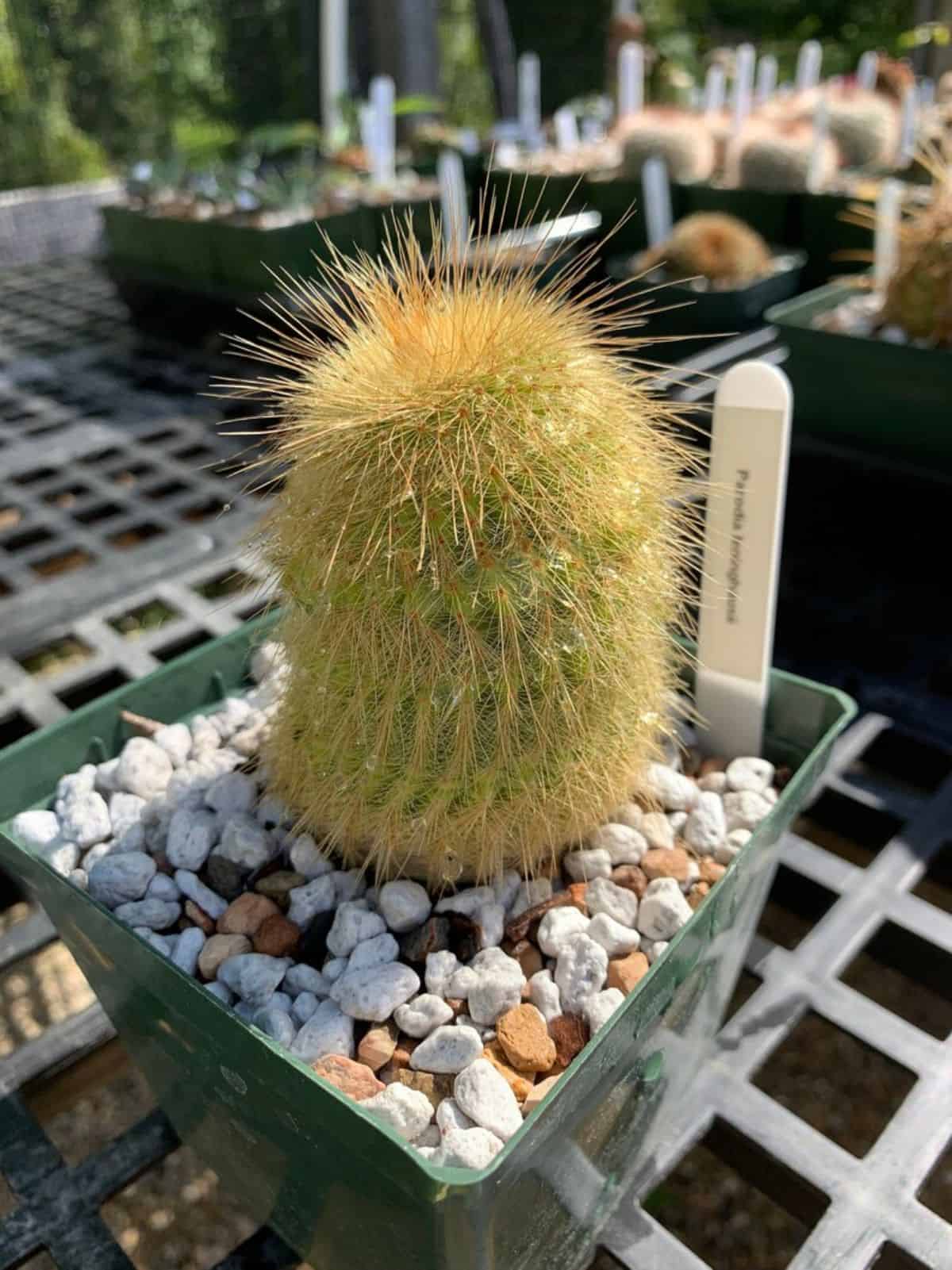
Buy it from:
| Maximum Height: | Up to 3 feet |
| Maximum Width: | Up to 5 inches |
| Watering Needs: | Water weekly during hot months (soak and dry method), monthly water in winter, or when showing signs of dehydration. |
| Soil Needs: | Well-draining soil |
| Light Needs: | Filtered sun in the hottest months |
| Hardiness Zone(s): | Zone 9 and up |
| Bloom Color and Shape: | Very large trumpet-shaped yellow flowers (up to 8 inches tall) with pronounced white stigma. |
| Stem Type: | Up to 30 ribs with dark green skin and columnar as it ages; skin is often obscured by spines |
| Spine Type: | Very soft and golden spines that give a yellow haze to the stem |
Also known as lemon ball cactus, golden ball cactus, and yellow tower cactus, this golden beauty is one to surely attract attention. It can form slight clusters and is one of the less dangerous species because of its soft spines. While they are soft, they add to the entire aesthetic of the plant by creating a golden halo around the entire cluster of tiny to tall towers.
2. Notocactus Schlosseri
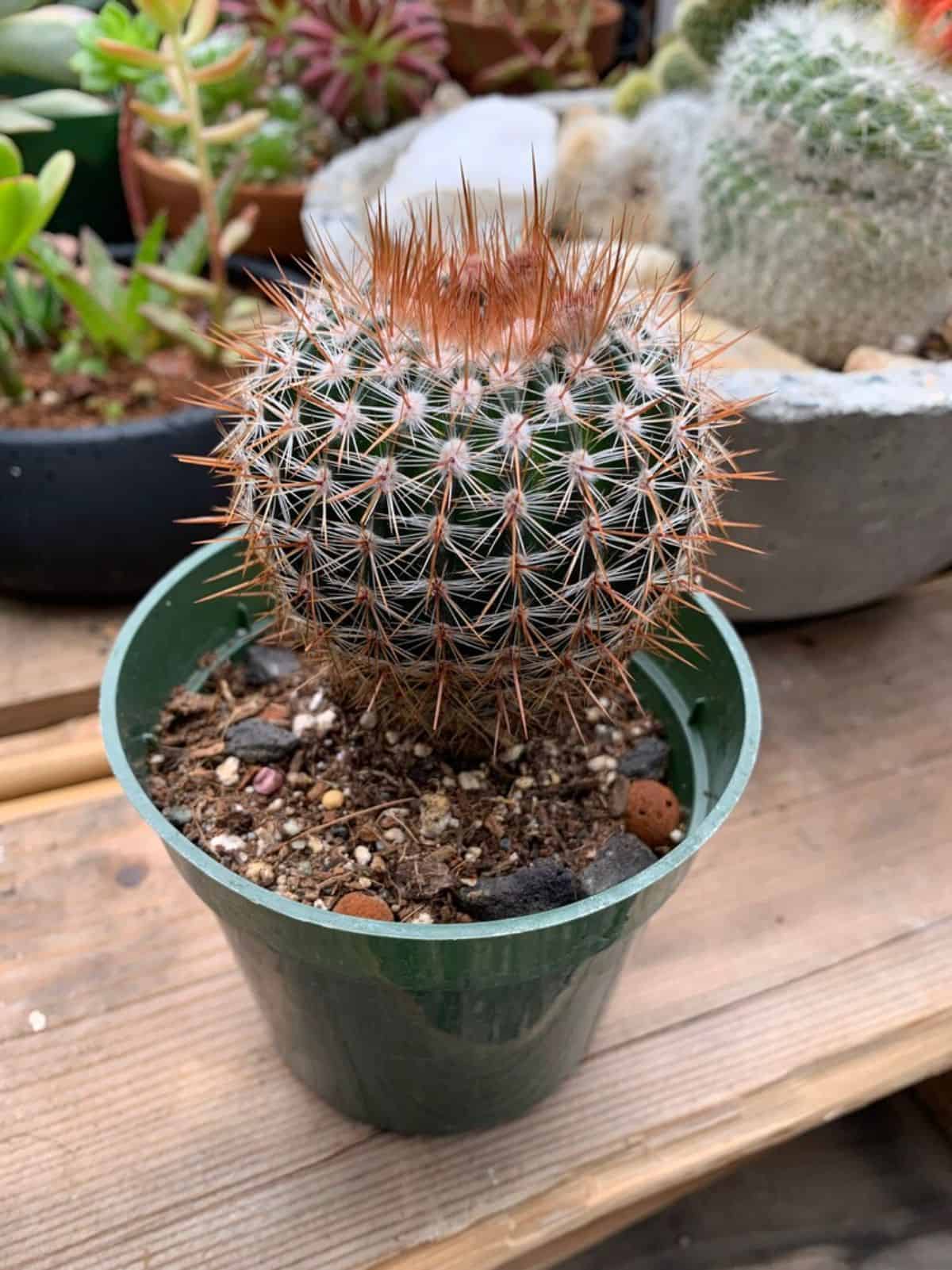
Buy it from:
| Maximum Height: | Up to 8 inches |
| Maximum Width: | Up to 5 inches |
| Watering Needs: | Water weekly during hot months (soak and dry method), monthly water in winter, or when showing signs of dehydration. |
| Soil Needs: | Well-draining soil |
| Light Needs: | Filtered sun in the hottest months |
| Hardiness Zone(s): | Zone 9 and up |
| Bloom Color and Shape: | Silky and a sunny yellow; trumpet-shaped with a very dark red stigma |
| Stem Type: | Shaped like a club or can be cylindrical; has prevalent white wool. |
| Spine Type: | Up to 34 radial spines that are thin and hair-like that grow along the stem; bright red-orange central spines that form a cross. |
Commonly called Schlosser's Hardy Notocactus, I find this species to be very characteristic of the common color scheme found with the notocactus. The spines are a dark brown but can also take on a reddish tinge to them, which accents the insanely bright yellow flowers. They tend to keep a more globe-like shape and, in all technicality, it is one of the more hardy notocacti.
3. Notocactus Buiningii
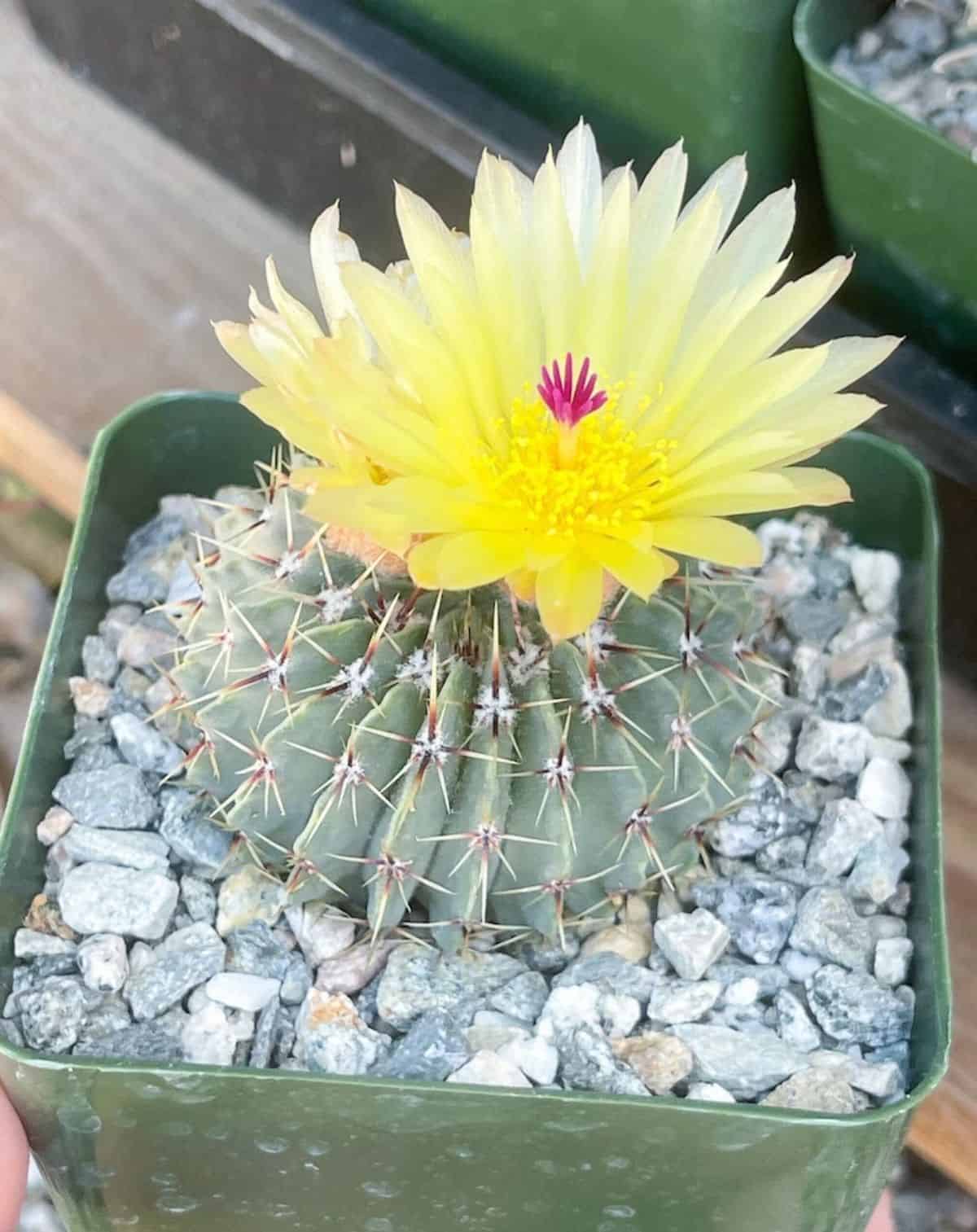
Buy it from:
| Maximum Height: | Up to 3 inches |
| Maximum Width: | Up to 5 inches |
| Watering Needs: | Water weekly during hot months (soak and dry method), monthly water in winter, or when showing signs of dehydration. |
| Soil Needs: | Well-draining soil |
| Light Needs: | Filtered sun in the hottest months |
| Hardiness Zone(s): | Zone 9 and up |
| Bloom Color and Shape: | Trumpet-shaped with bright yellow and glossy petals; stigma is almost maroon in color |
| Stem Type: | Wooly towards the top with a slight depression; tends to be a lighter green, |
| Spine Type: | Up to 3 radial spines that are smaller than the 4 cross-forming and very stiff straw-colored central spines. |
Compared to other notocacti, this species maintains a much lighter emerald green. The ribs are also heavily pronounced, which makes it hard for the radial spines to wrap around the skin. Spines are extremely prominent and dangerous: handle them with care. Another feature of this species is that the flowers are nyctinastic. This means that they close at night and open in the morning.
4. Notocactus haselbergii
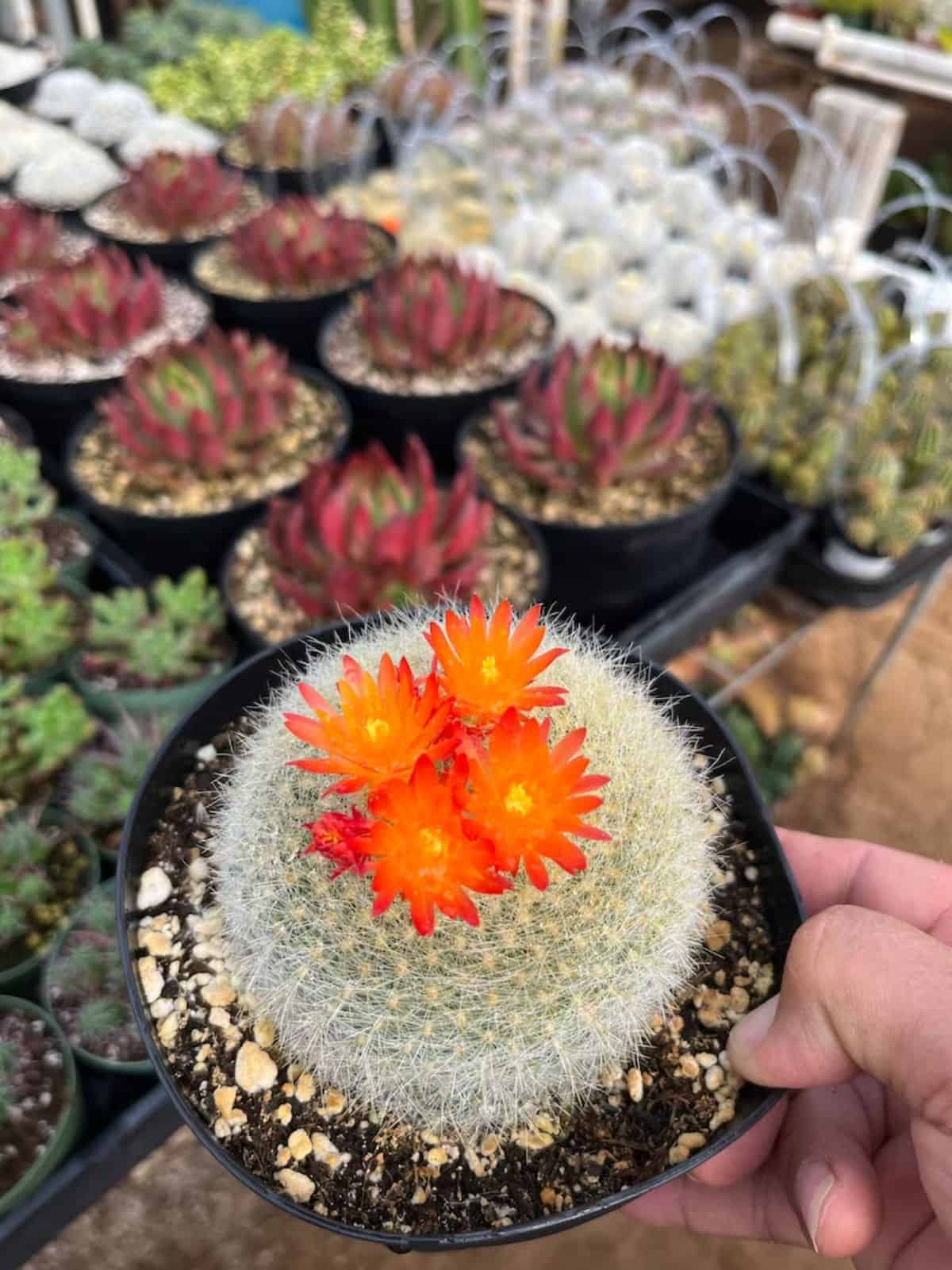
Buy it from:
| Maximum Height: | Up to 4 inches |
| Maximum Width: | Up to 6 inches |
| Watering Needs: | Water weekly during hot months (soak and dry method), monthly water in winter, or when showing signs of dehydration. |
| Soil Needs: | Well-draining soil |
| Light Needs: | Filtered sun in the hottest months |
| Hardiness Zone(s): | Zone 9 and up |
| Bloom Color and Shape: | Long-lasting bright red trumpet flowers |
| Stem Type: | Slightly depressed top and tends to cluster starting at a young age. |
| Spine Type: | 60+ straw/white colored spines that obscure the cactus; central spines are thicker and grow straight out from the areoles. |
The Scarlet Ball! It’s one of the few in this genus that have such vibrantly red flowers that last an incredibly long time for the genus. Most flowers last days to a week but these last up to three weeks. Additionally, they are very fluffy looking, but the radial spines are sharp and get stuck in skin and clothes very easily.
5. Notocactus Uebelmannianus
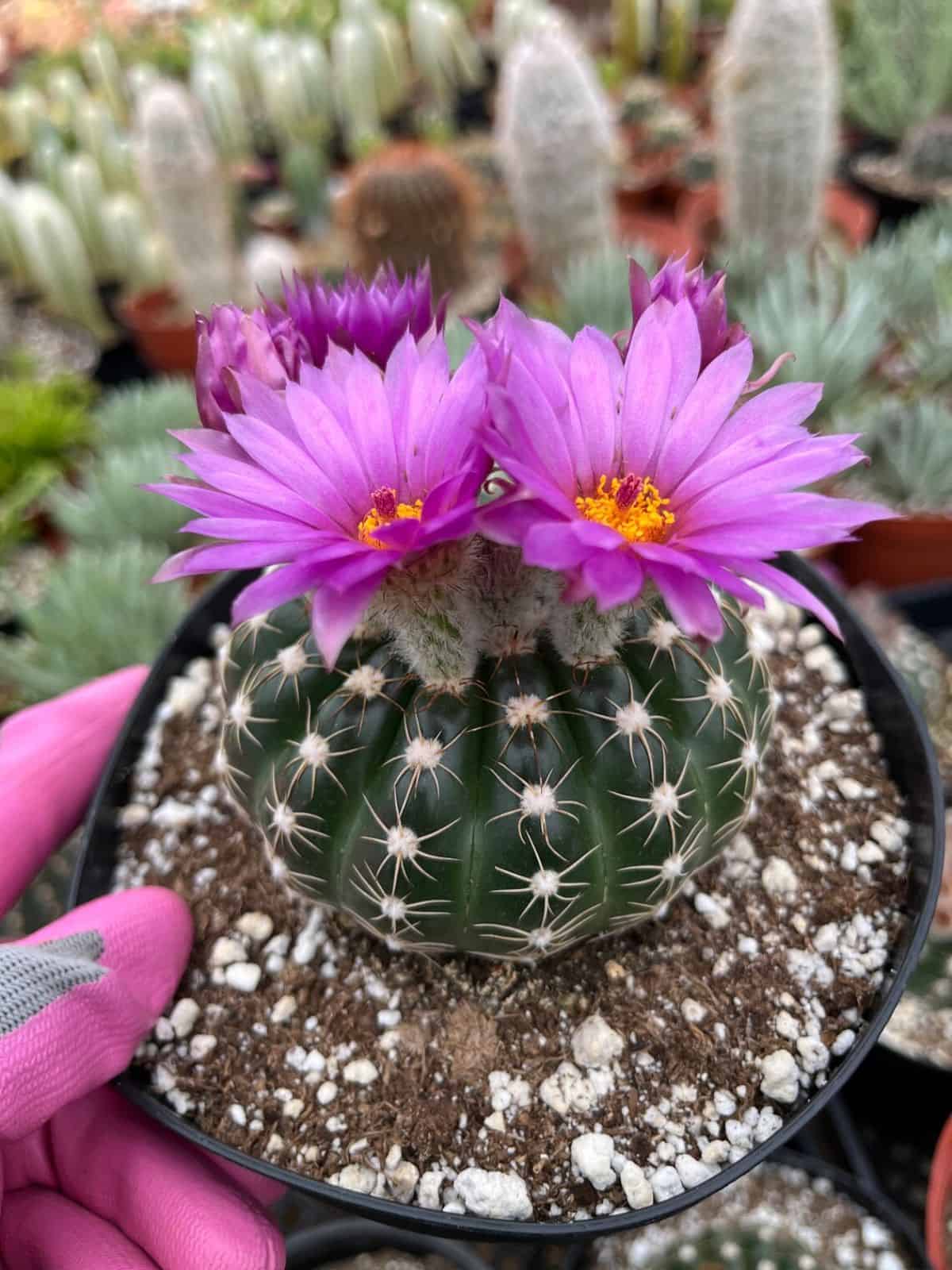
Buy it from:
| Maximum Height: | Up to 5 inches |
| Maximum Width: | Up to 7 inches |
| Watering Needs: | Water weekly during hot months (soak and dry method), monthly water in winter, or when showing signs of dehydration. |
| Soil Needs: | Well-draining soil |
| Light Needs: | Filtered sun in the hottest months |
| Hardiness Zone(s): | Zone 9 and up |
| Bloom Color and Shape: | Smaller flowers that are only a few inches long; glossy, and funnel-shaped with a fuschia color and rarely wine color. |
| Stem Type: | Globular with depressions where the wooly areoles occur, Has up to 16 ribs. |
| Spine Type: | Up to 6 radial spines that grow along the skin of the cactus; central spines are rare to find. |
Now we’re getting into a few different features of the notocactus genus. This species is known for its smooth skin that looks like a bell pepper. However, it is also known as one of the few species where both it's fuschia/purple/wine and yellow flowers can exist on the same plant. This is extremely rare, and if you find one that has this characteristic, snatch it up right away!
6. Notocactus Concinnus
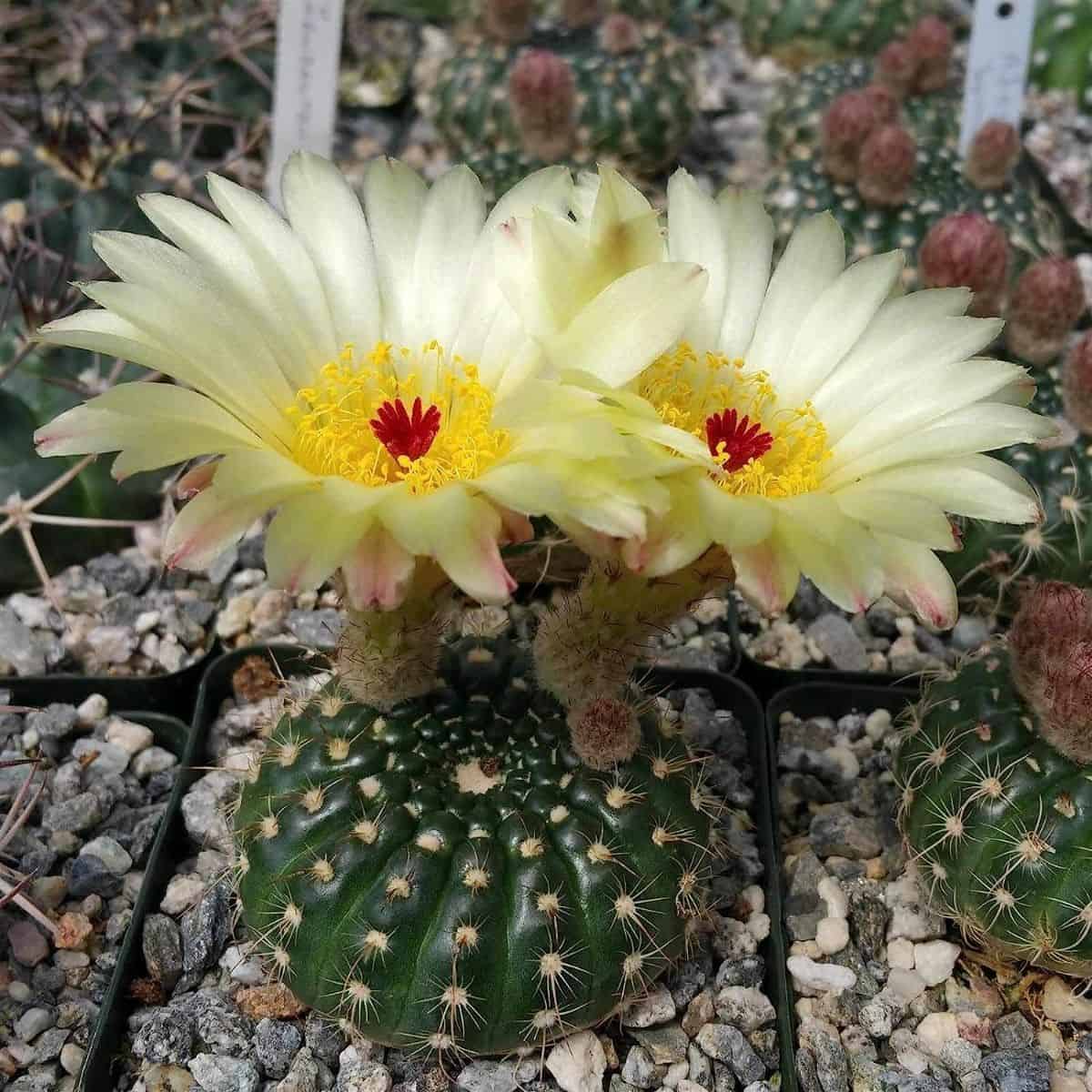
Buy it from:
| Maximum Height: | Up to 4 inches |
| Maximum Width: | Up to 4 inches |
| Watering Needs: | Water weekly during hot months (soak and dry method), monthly water in winter, or when showing signs of dehydration. |
| Soil Needs: | Well-draining soil |
| Light Needs: | Filtered sun in the hottest months |
| Hardiness Zone(s): | Zone 9 and up |
| Bloom Color and Shape: | Trumpet-shaped yellow flowers with some pink expressed along the middle; the stigma is bright red and curved upward. |
| Stem Type: | Maintains globular shape with up to 20 ribs. Skin is dark glossy green. |
| Spine Type: | Up to 25 Spider-like radial spines that grow along the stem, with up to 6 central spines that grow downward |
Also commonly called a krinkle plant because of how the areoles create drastic depressions in the ribs, this little beauty is one that stays little. The flowers constantly dwarf the main globe by several inches considering this species stays globular and doesn’t get above four inches in diameter.
7. Parodia Scopa
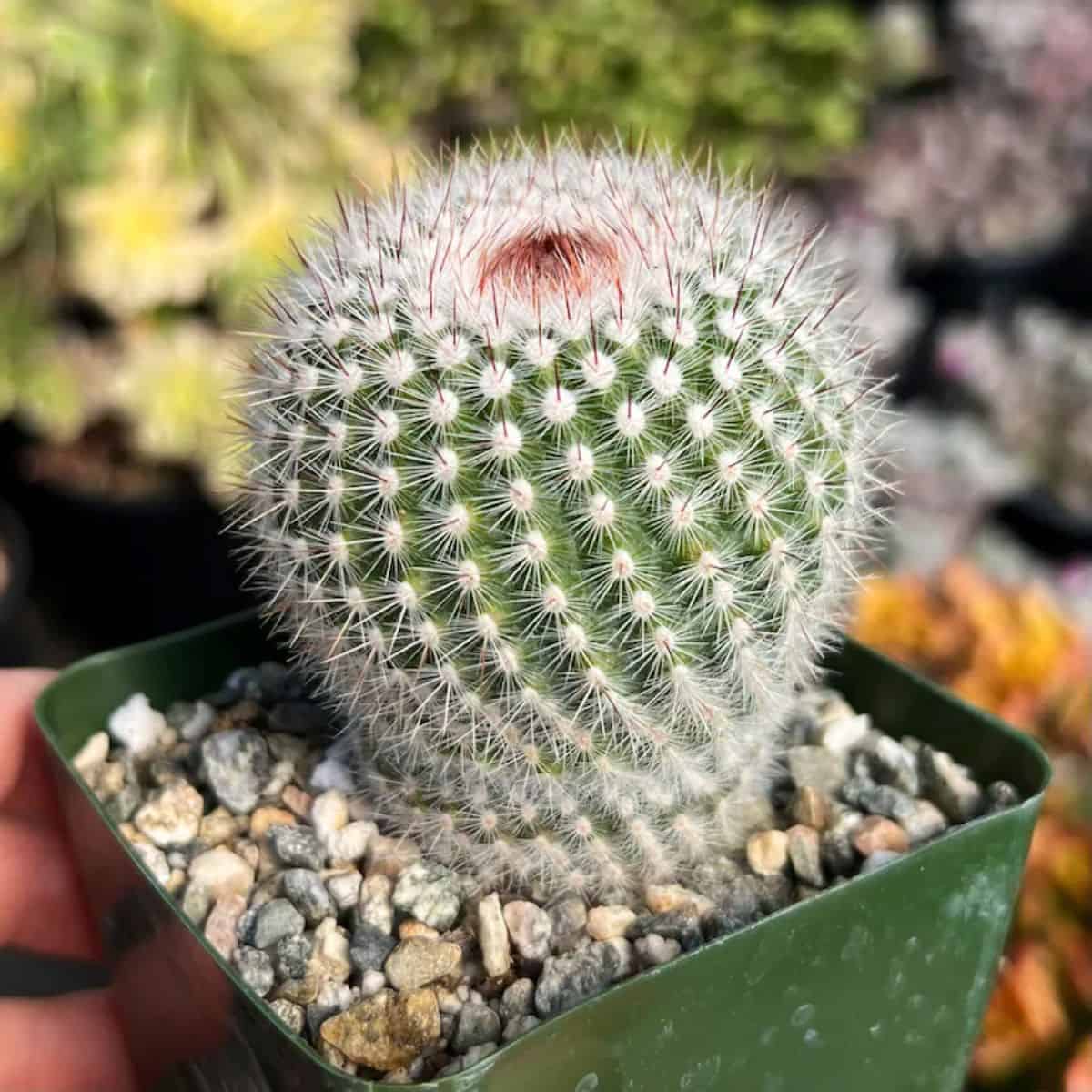
Buy it from:
| Maximum Height: | Up to 18 inches |
| Maximum Width: | Up to 5 inches |
| Watering Needs: | Water weekly during hot months (soak and dry method), monthly water in winter, or when showing signs of dehydration. |
| Soil Needs: | Well-draining soil |
| Light Needs: | Filtered sun in the hottest months |
| Hardiness Zone(s): | Zone 9 and up |
| Bloom Color and Shape: | Glossy yellow flowers with large red stigma |
| Stem Type: | Up to 40 or more ribs with wooly areoles, will be columnar with maturity. |
| Spine Type: | Bristle-like radial spines, red central spines that form a cross |
If you haven’t caught on to the trend, many of the notocacti species are referred to as balls, and this parodia isn’t any different. Commonly called Silver Ball cactus, the species takes on a lovely white and silvery color thanks to the spines and the collection of wool around the evenly spaced areoles. It is a columnar species of notocactus, but it takes a long time for this species to reach the height listed in the chart above.
8. Notocactus Magnificus
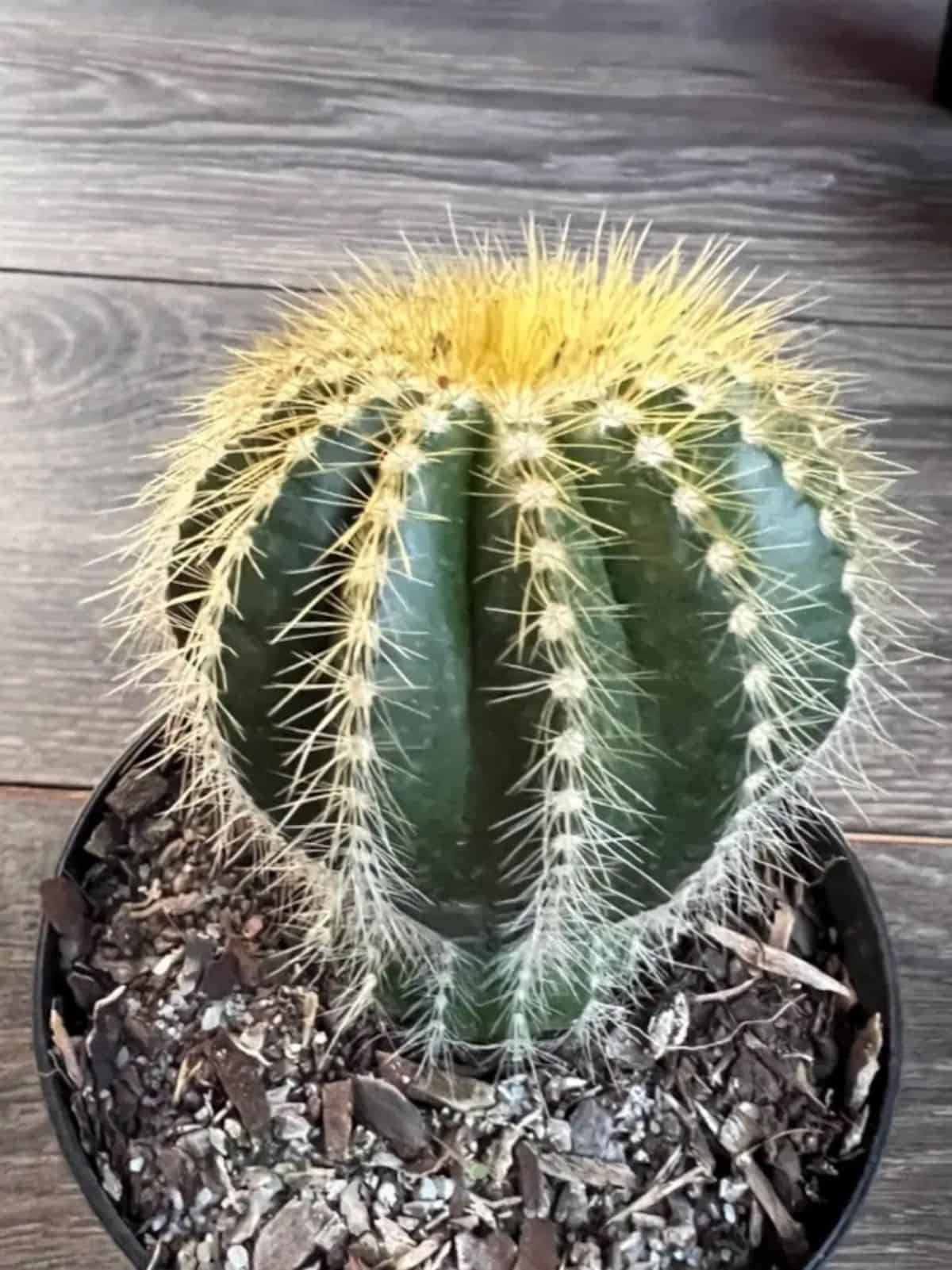
Buy it from:
| Maximum Height: | Up to 12 inches |
| Maximum Width: | Up to 6 inches |
| Watering Needs: | Water weekly during hot months (soak and dry method), monthly water in winter, or when showing signs of dehydration. |
| Soil Needs: | Well-draining soil |
| Light Needs: | Filtered sun in hottest months; prefers full sun otherwise. |
| Hardiness Zone(s): | Zone 9 and up |
| Bloom Color and Shape: | Highlighter yellow flowers, funnel-shaped with dense wool at the base. |
| Stem Type: | Up to 15 ribs, tends to stay columnar |
| Spine Type: | Lacks central spines; up to 15 bristle-like spines |
There’s a reason that this species is magnificent! Its common name is the Balloon cactus, and it can either grow as a singular plant or cluster. The ribs are easily defined and lined with a very attractive collection of straw-to-gold spines. It is easier to handle than other species thanks to the soft bristles, but its best feature is the beauty of the extremely bright flowers!
9. Notocactus Elegans
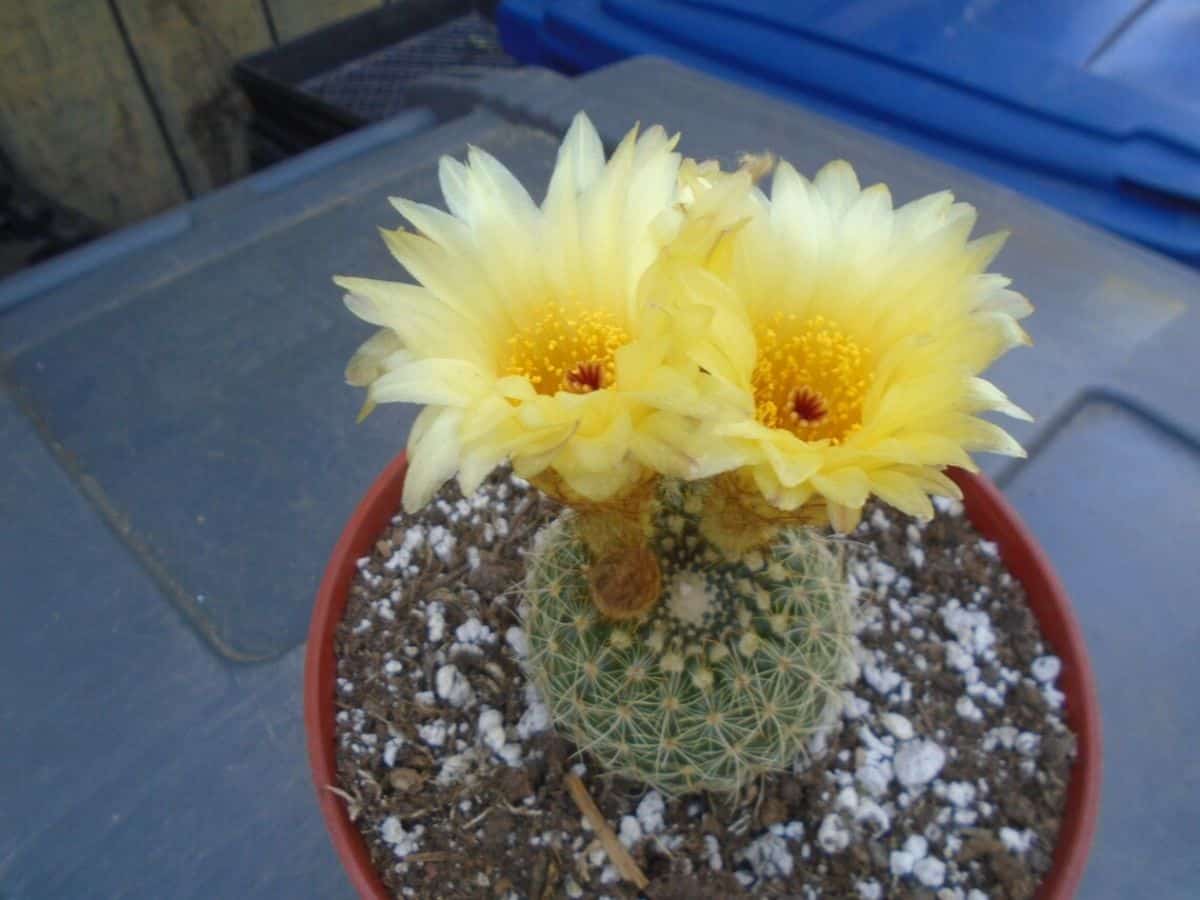
Buy it from:
| Maximum Height: | Up to 1 foot |
| Maximum Width: | Not Found |
| Watering Needs: | Water weekly during hot months (soak and dry method), monthly water in winter, or when showing signs of dehydration. |
| Soil Needs: | Well-draining soil |
| Light Needs: | Filtered sun in the hottest months |
| Hardiness Zone(s): | Zone 9 and up |
| Bloom Color and Shape: | Pale white daisy-like flower with a yellow throat and red stigma; funnel-shaped. |
| Stem Type: | Stays globose and more flattened |
| Spine Type: | White radial spines with reddish central spines |
If you are looking for a notocactus that has a bit more of a gentle look, then this is the species that you want to grab. The growth type and flowers are very similar to the rest of the genus; however, the flowers set it apart. Instead of having thicker petals (width-wise), the petals tend to be thinner and more ethereal looking.
10. Notocactus Ottonis
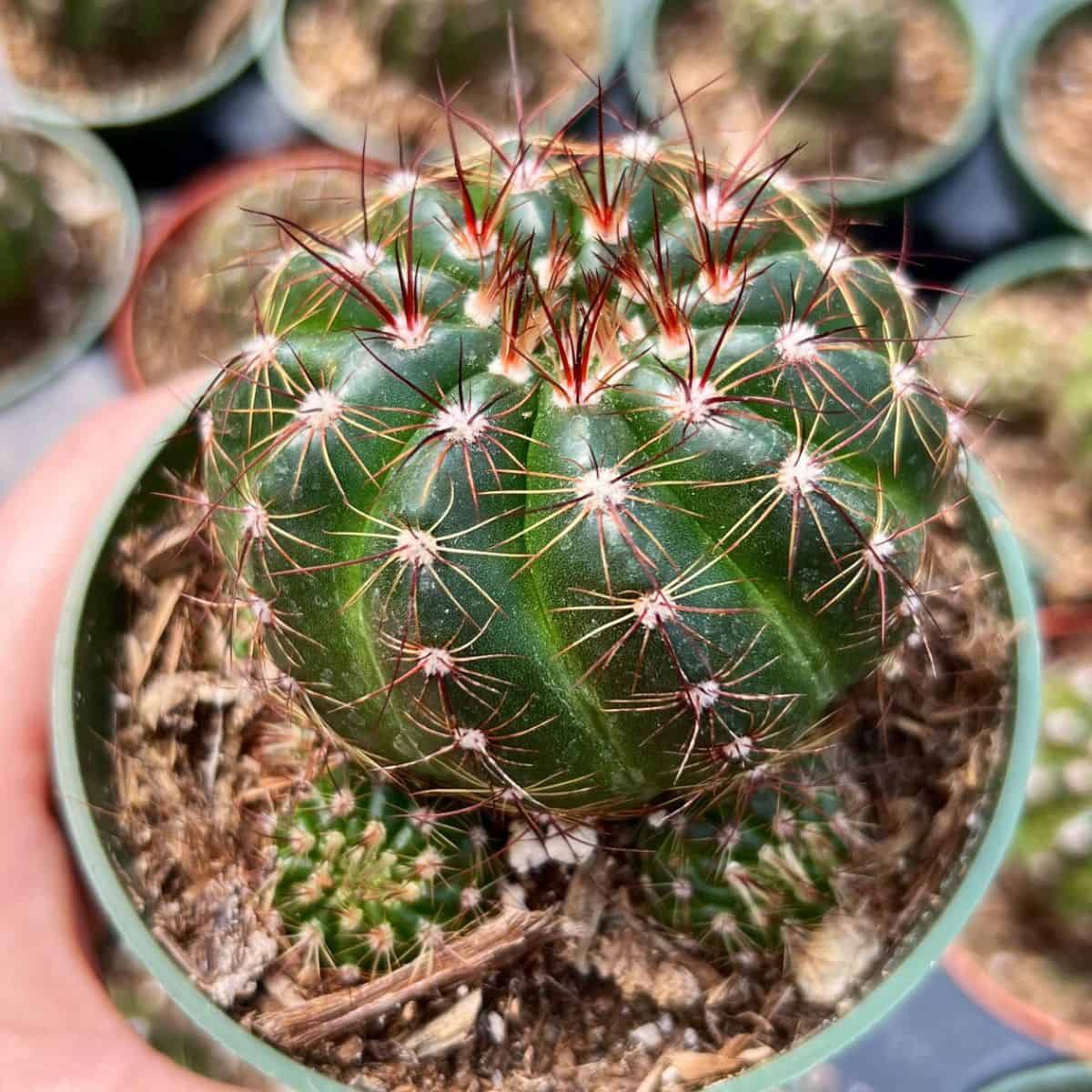
Buy it from:
| Maximum Diameter: | Up to 6 inches |
| Watering Needs: | Water weekly during hot months (soak and dry method), monthly water in winter, or when showing signs of dehydration. |
| Soil Needs: | Well-draining soil |
| Light Needs: | Filtered sun in the hottest months |
| Hardiness Zone(s): | Zone 9 and up |
| Bloom Color and Shape: | Bright yellow and glossy bell-shaped flower with a yellow throat and red stigma |
| Stem Type: | More so rounded with dark green flesh and up to 12 ribs. Very rare for specimens to have 15 ribs. |
| Spine Type: | Several hair-like radial spines with up to 6 central spines that can take on a rose color; central spines tend to curve downward. |
Commonly known as the Indian head cactus, this species can come with a variety of colored flowers. The most common is a bright yellow flower; however, there are the more rare red-orange to bright red varieties. The flowers also have a translucent factor to them, and they are triple-layered.
11. Notocactus Werdermannianus
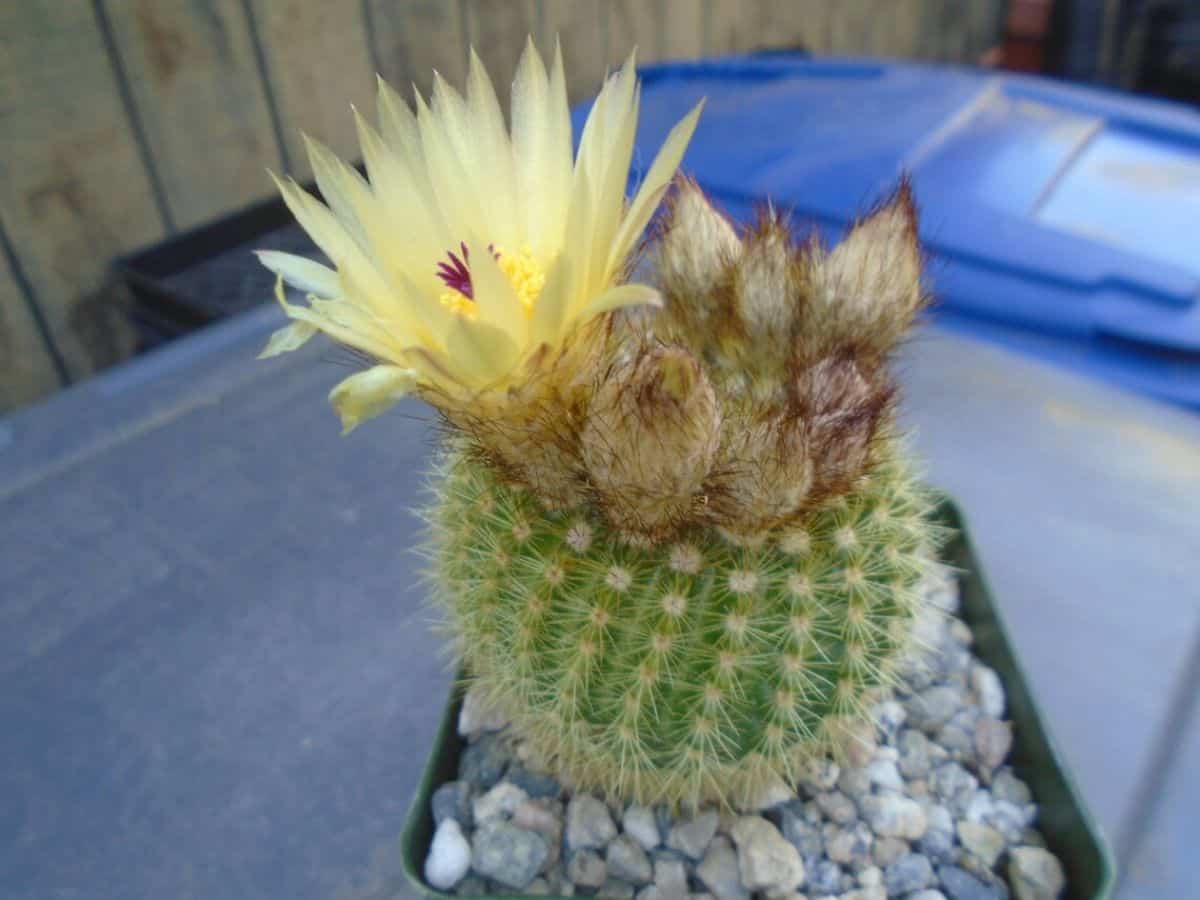
Buy it from:
| Maximum Height: | Up to five inches |
| Maximum Width: | Up to 4 inches |
| Watering Needs: | Water weekly during hot months (soak and dry method), monthly water in winter, or when showing signs of dehydration. |
| Soil Needs: | Well-draining soil |
| Light Needs: | Filtered sun in the hottest months |
| Hardiness Zone(s): | Zone 9 and up |
| Bloom Color and Shape: | More trumpet-shaped, glossy, and buttery petals. Yellow center with bright red stigma |
| Stem Type: | Usually has a depression at the top and has up to 40 ribs with bumps underneath the areoles. |
| Spine Type: | Up to 20 erect radial spines with four cross-like central spines. The lower central spine can take on a reddish color |
One of the most captivating features of Notocactus werdermannianus is its stunning display of flowers. Typically appearing in spring or early summer, the cactus produces a crown of striking yellow flowers that emerge from the top of the plant. These flowers are often large and showy, brightening up the surrounding landscape. They have a trumped-shaped structure with numerous petals and a vibrant yellow color, attracting pollinators such as bees and butterflies.
12. Notocactus Roseoluteus
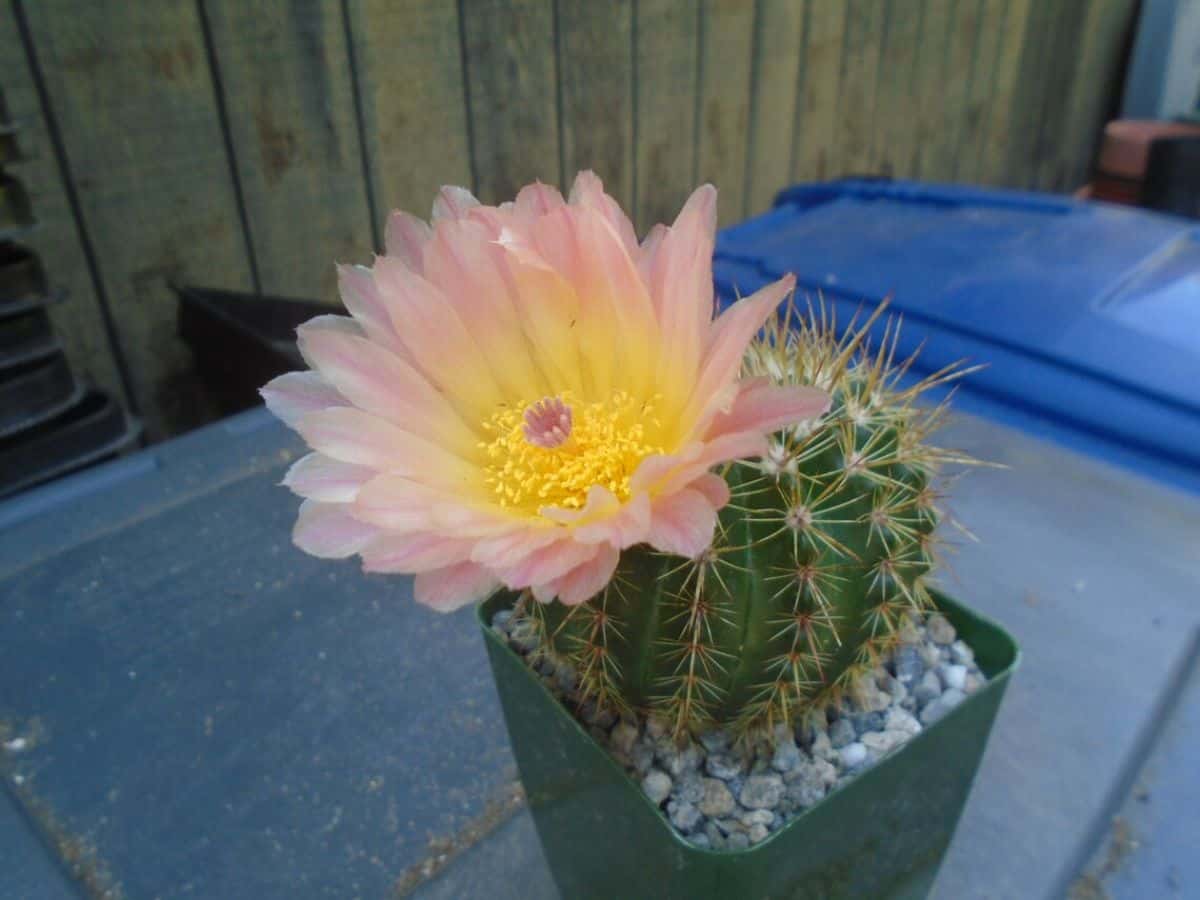
Buy it from:
| Maximum Diameter: | Up to 7 inches |
| Watering Needs: | Water weekly during hot months (soak and dry method), monthly water in winter, or when showing signs of dehydration. |
| Soil Needs: | Well-draining soil |
| Light Needs: | Filtered sun in the hottest months |
| Hardiness Zone(s): | Zone 9 and up |
| Bloom Color and Shape: | Salmon with concentrated pink midvein. Yellow center and glossy petals with bell shape |
| Stem Type: | Stays flattened but can become cylindrical when mature |
| Spine Type: | Up to 11 soft radial spines with a hard awl-shaped central spine |
According to most sources, this is one species of notocactus that isn’t usually all that popular or well-known. It does also have a few names, which can cause some confusion. It is also known as Notocactus cupreatus and Parodia mammulosa. There can be some rotation to the ribs as well, but this isn’t that common of a feature.
13. Notocactus mammulosus
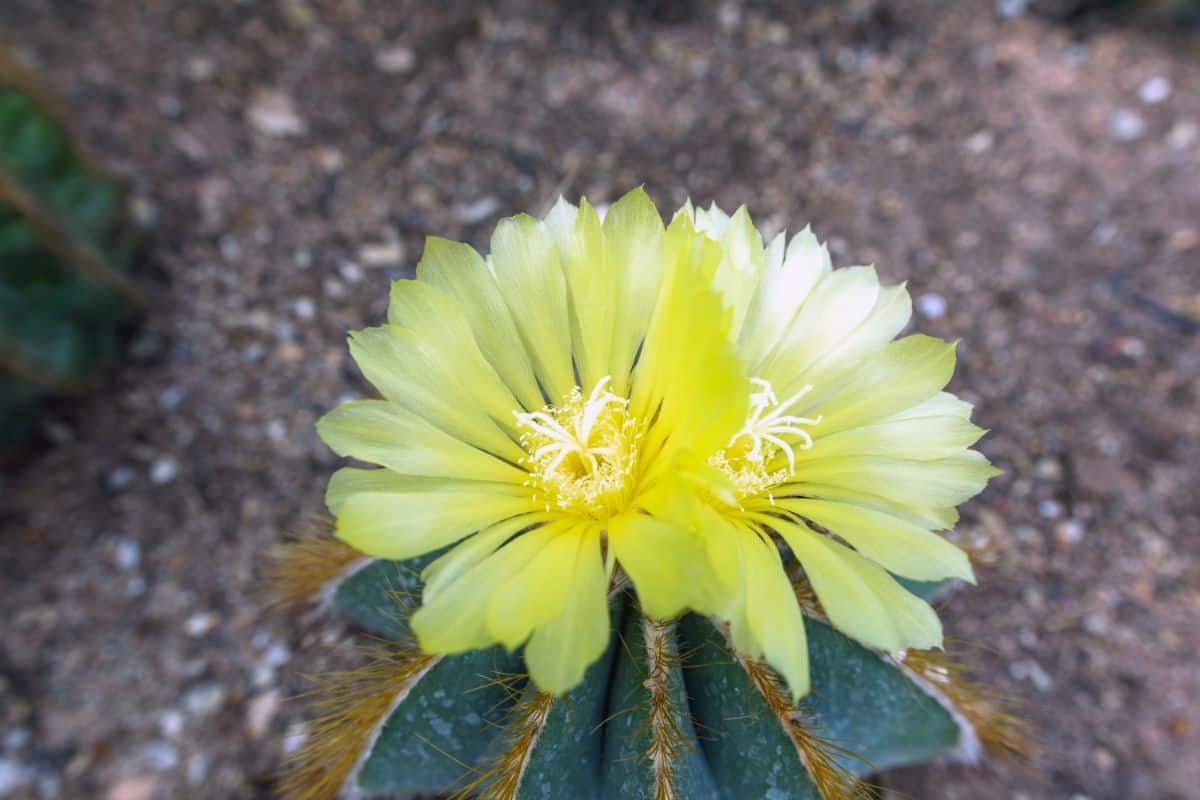
Buy it from:
| Maximum Height: | Up to 4 inches |
| Maximum Width: | Up to 5 inches |
| Watering Needs: | Water weekly during hot months (soak and dry method), monthly water in winter, or when showing signs of dehydration. |
| Soil Needs: | Well-draining soil |
| Light Needs: | Filtered sun in the hottest months |
| Hardiness Zone(s): | Zone 9 and up |
| Bloom Color and Shape: | Can be pale pink to yellow; both colors are glossy and slightly transparent. The stigma is violet, no matter the petal color. |
| Stem Type: | Globe-like that can become slightly columnar; up to 25 ribs with pronounced tubercles between areoles. |
| Spine Type: | Up to 30 radial white spines and up to 4 central spines that are rarely differentiated; they may be slightly flattened. |
The Tom Thumb or Lemon Ball is one of the most widespread, variable, cross-pollinated, and most difficult species to identify. Due to where it appears and how prolific this species is, there are hundreds of crosses that change the form just enough to make it practically impossible to determine the pure parent species.
14. Parodia mueller-melchersii
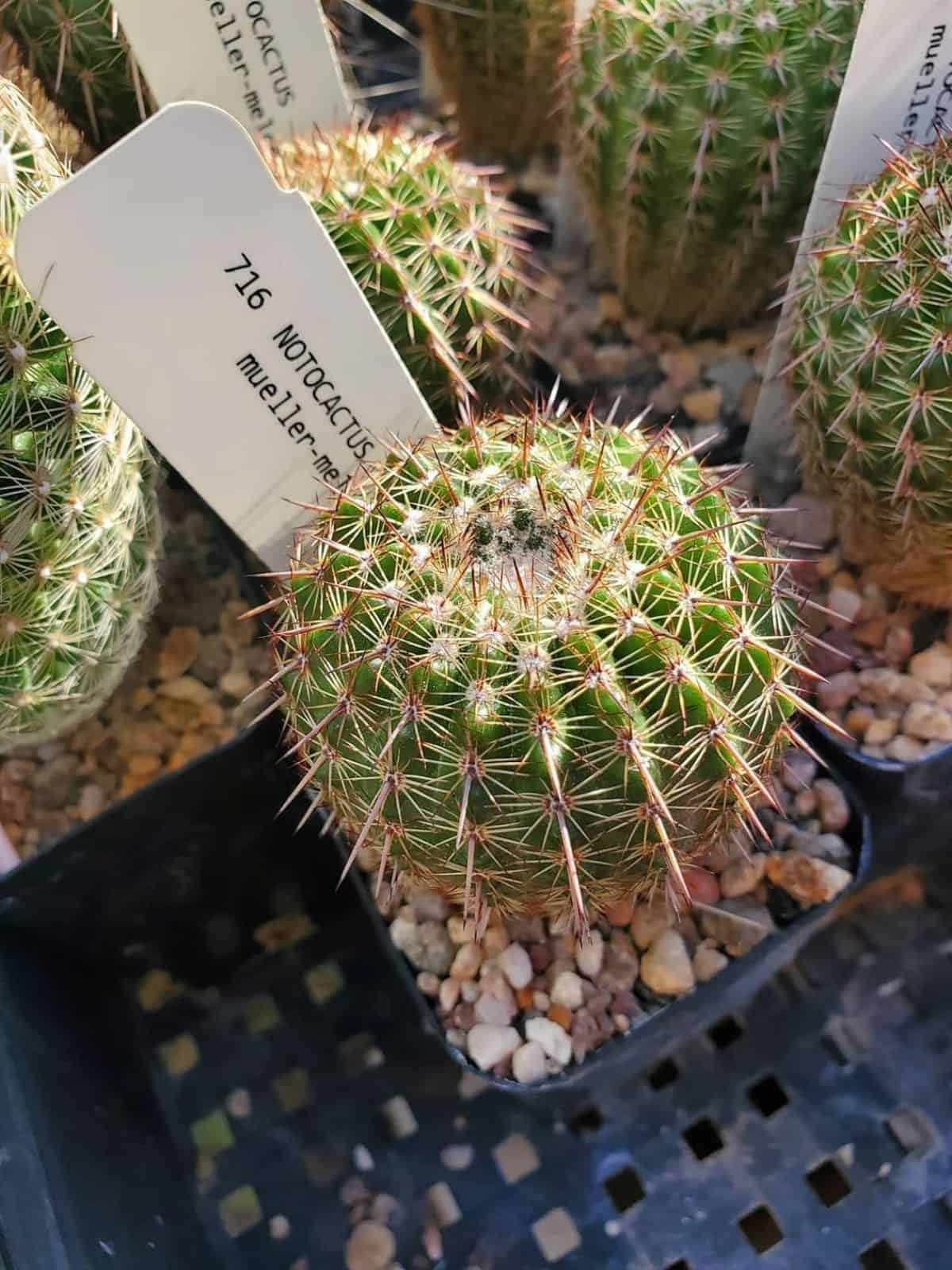
Buy it from:
| Maximum Diameter: | Up to 2 inches |
| Watering Needs: | Water weekly during hot months (soak and dry method), monthly water in winter, or when showing signs of dehydration. |
| Soil Needs: | Well-draining soil |
| Light Needs: | Filtered sun in the hottest months |
| Hardiness Zone(s): | Zone 9 and up |
| Bloom Color and Shape: | Can be salmon, red, or rose; all three colors have yellow throats. |
| Stem Type: | Tends to stay in a perfect globe; however, it can become slightly columnar as it grows. |
| Spine Type: | Up to 16 radial spines that are white with darker tips; up to 2 reddish central spines |
Rightly named the Pink Ball cactus, with another species name of Notocactus rutilans (Parodia rutilans), this tiny beauty has one of the most gorgeous trumpeted flowers that fade from a yellow throat to bubblegum pink. This is what gives it its name. The flowers tend to start blooming at a young age as well which dwarfs the globular stem.
15. Notocactus apricus
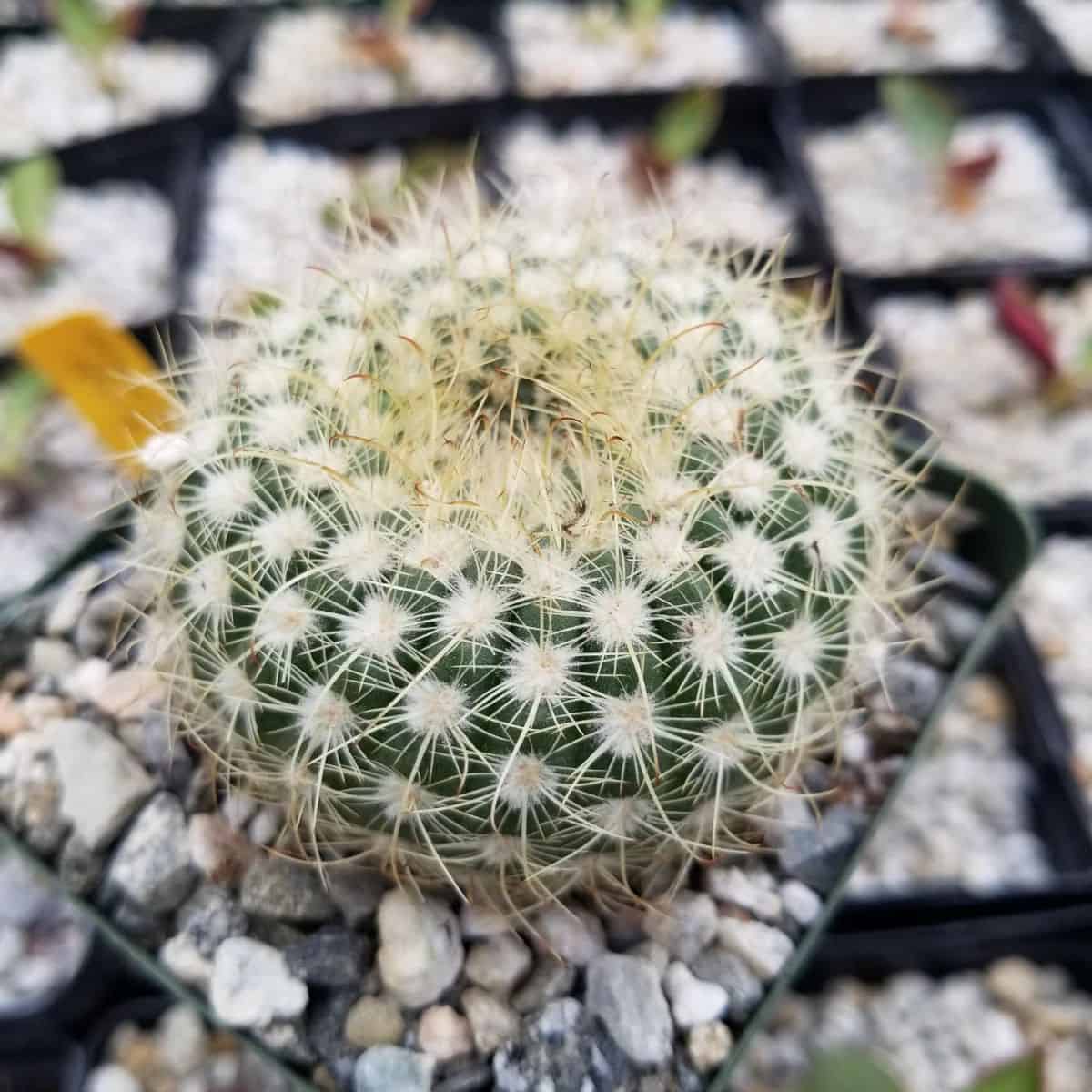
Buy it from:
| Maximum Diameter: | Up to 1.5 inches |
| Watering Needs: | Water weekly during hot months (soak and dry method), monthly water in winter, or when showing signs of dehydration. |
| Soil Needs: | Well-draining soil |
| Light Needs: | Filtered sun in the hottest months |
| Hardiness Zone(s): | Zone 9 and up |
| Bloom Color and Shape: | Narrow and funnel-shaped, yellow with a bright red center. |
| Stem Type: | Stays flattened but can become cylindrical when mature; will branch up to 10 times |
| Spine Type: | Up to 20 radial spines that are bristle-like, up to 4 central spines with a slight downward bend. Young spines are red. |
One of the very few species that does well in full sun almost year-round, N. apricus is usually just referred to as a ball cactus which is common for most notocacti. In this collection, it is one of the smallest notocacti that I could find, and it doesn’t fail to impress with showy flowers and equally showy young red spines.

